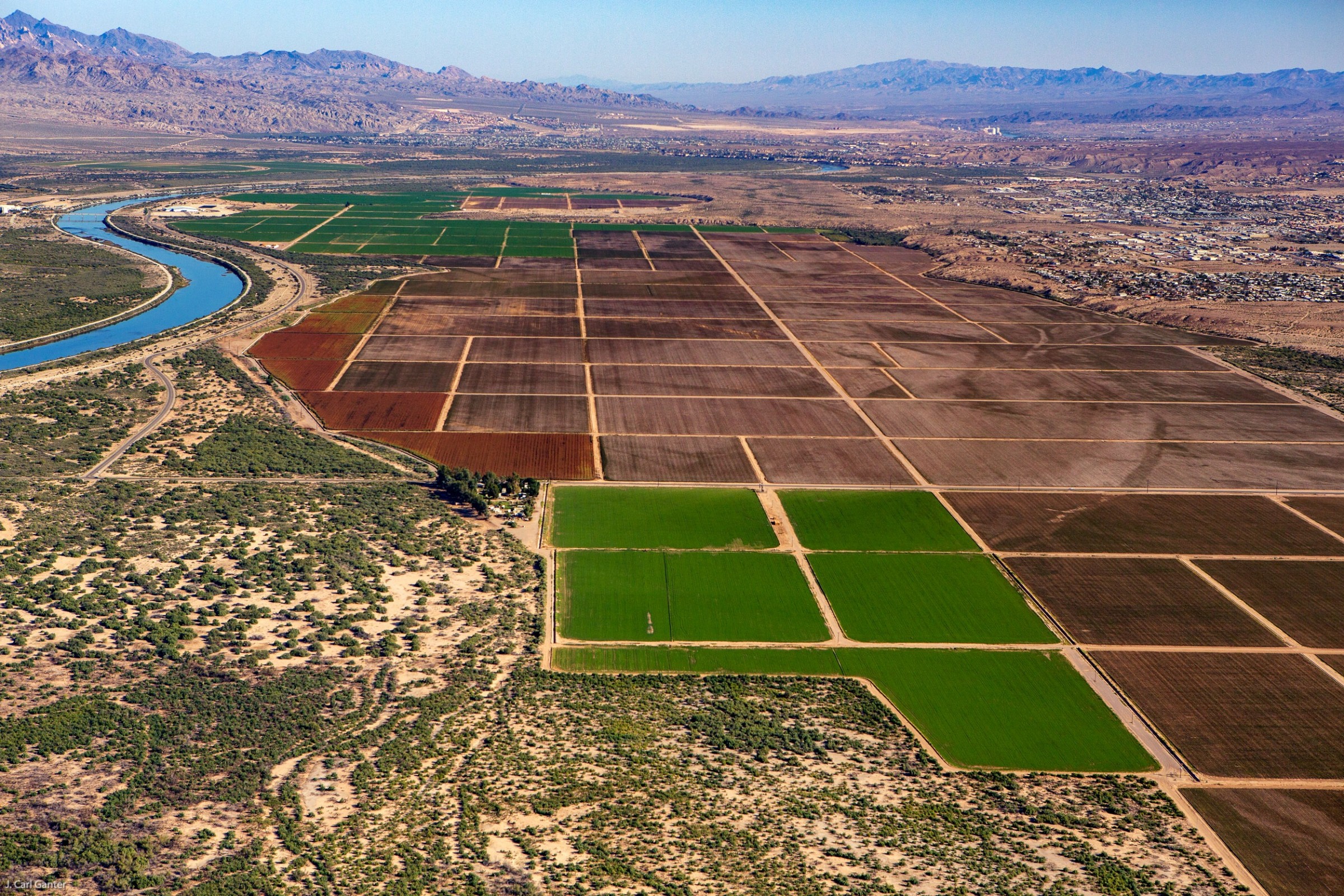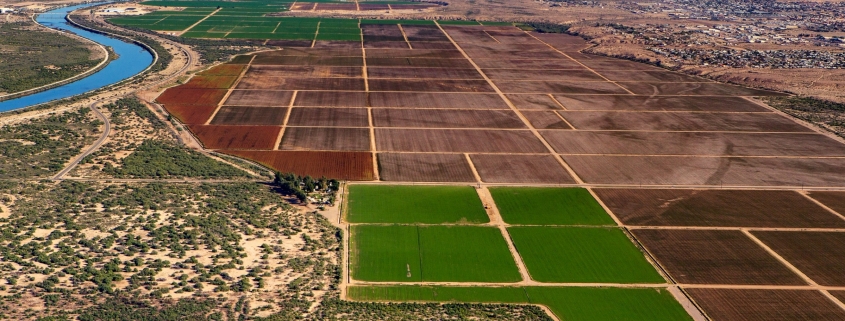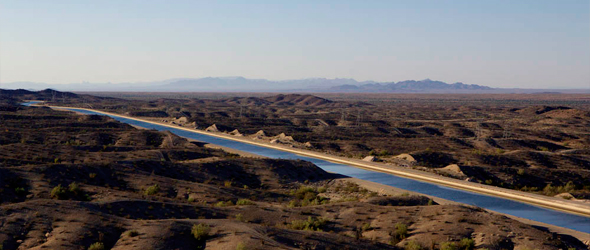Colorado River Indian Tribes Take Another Step Toward Marketing Valuable Water in Arizona
The tribes unveiled draft legislation to allow their water to be leased to users in Arizona off the reservation or stored underground.

The Colorado River Indian Tribes reservation straddles its namesake river. Shown here are irrigated fields in the portion of the reservation in Arizona. Photo © J. Carl Ganter/Circle of Blue
By Brett Walton, Circle of Blue
The water rights held by the Colorado River Indian Tribes are a valuable asset, and tribal leadership is seeking congressional approval to cash in on them — for the benefit of the tribes and the state’s high-growth cities and maybe the environment.
The tribes — known as CRIT for short — have lands that stretch along 56 miles of the lower Colorado River. Eighty-five percent of the reservation is in Arizona, with the remainder in California. The tribes’ right to divert 662,402 acre-feet from the river for use on land in Arizona is more than twice the Colorado River water that is allocated to the state of Nevada.
By law, that water is to be used on the reservation. But if CRIT convinces Congress to allow off-reservation leasing, the legal change would free up a large volume of water in a region that is mired in a severe drought and is drying out as the planet warms. According to CRIT’s planning, as much as 150,000 acre-feet per year could be made available for leasing.
That water would be highly desirable for high-growth cities and industries in the urban corridor between Phoenix and Tucson, where four out of five state residents live. Money from the leases would allow the tribes to pay for improvements to irrigation infrastructure, health care, education, law enforcement, and other government services. Environmental groups see the potential for leased water to be used for habitat restoration.
Amelia Flores, elected this week as the next CRIT chair, said she “fully supports” the effort to secure federal legislation to allow water leasing.
“This is our economic future,” Flores said in a statement. “It is needed for water security in Arizona, and with it we will be better able to protect the river for future generations.”
Fairness and Flexibility
The effort to market its water began years ago, said Dennis Patch, current CRIT chairman. It ramped up recently as the drying of the Southwest began to put pressure on water supplies in the entire Colorado River basin.
“The concern over shortages in the lower Colorado River has sharpened our focus on doing what we can to save the life of the river,” Patch said.
In a referendum in January 2019, CRIT members authorized the council to seek congressional approval for leasing. The vote was prompted by an attempt in 2018 to recall all nine council members over some residents’ objections to water leasing.
CRIT’s water rights are not like those held by most tribes in the American West. Other tribes quantified their rights through acts of Congress. CRIT, by contrast, secured its water through a U.S. Supreme Court decision, in 1963. Because the CRIT water rights are held in trust by the federal government, Congress must explicitly authorize off-reservation leases, said Margaret Vick, the tribes’ water lawyer.
CRIT unveiled draft federal legislation in October.
In Arizona, tribes that receive water from the Central Arizona Project canal are allowed to lease their water. Several have done so, including the Gila River Indian Community, which signed a $27.6 million agreement with Phoenix in 2008. Under the 100-year lease, the tribe provides 15,000 acre-feet per year to the city.
In addition to federal legislation, CRIT’s leasing program requires other authorizations. The tribes will enter into an agreement with the Arizona Department of Water Resources and the Bureau of Reclamation for verifying and reporting the amount of water leased. A second agreement with the state outlines the notification process about the leased water.
The Arizona Department of Water Resources told Circle of Blue that the purpose of the agreement is for sharing information only. The state will not have veto authority over any leases. Public comments on the agreements are being accepted through January 8.
Crucially, the leased water retains its top position in Arizona’s priority system. That means the water is the first to be delivered out of the state’s Colorado River allocation and is highly unlikely to be cut off – which is valuable insurance when river flows have already waned because of a warming planet and are expected to weaken further.
The proposed legislation has several caveats. It does not apply toward CRIT’s water rights on the California portion of the reservation. The leased water cannot be used in the northeastern corner of Arizona, which is outside the lower basin. And leased water must come from a reduction in consumptive use on CRIT lands.
“This is a win for Arizona water users, for the river, for our people, and for the reservation economy,” Patch said. CRIT is already proving its commitment to assist the basin. The tribes are participating in a land-fallowing program that stores the conserved water in Lake Mead.
Others providing public comment at a hearing this week agreed.
Jennifer Pitt, the Colorado River program director at the National Audubon Society, gave her “enthusiastic support” for the proposal, arguing that it was a matter of fairness and flexibility. Fairness because other tribes are allowed to lease water. And flexibility because more water shortages are in the basin’s future.
Pitt also noted the potential for leases to support ecosystem health. “In this way, a lease of water from the CRIT tribe could, if desired, provide habitat for dozens of endangered species, including the southwest willow flycatcher and the Yuma Ridgway’s rail,” she said. “It could re-create culturally significant landscapes that are important for Native American tribes, and it could restore nature for all people to experience a living and thriving river.”
CRIT’s reservation was established in 1865. Tribal leaders today say that it is time for them to take control.
“This is about our self-determination,” said Tommy Drennan, a member of the CRIT council. Drennan added: “It’s now our time to be in charge of our water.”
Brett writes about agriculture, energy, infrastructure, and the politics and economics of water in the United States. He also writes the Federal Water Tap, Circle of Blue’s weekly digest of U.S. government water news. He is the winner of two Society of Environmental Journalists reporting awards, one of the top honors in American environmental journalism: first place for explanatory reporting for a series on septic system pollution in the United States(2016) and third place for beat reporting in a small market (2014). He received the Sierra Club’s Distinguished Service Award in 2018. Brett lives in Seattle, where he hikes the mountains and bakes pies. Contact Brett Walton











Leave a Reply
Want to join the discussion?Feel free to contribute!